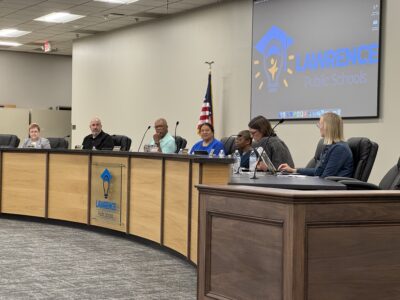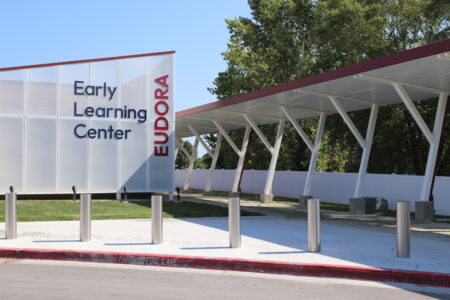Lawrence school board caps property tax with a slight increase as enrollment, some state funding shrinks

photo by: Josie Heimsoth/Journal-World
Lawrence school board members met on Monday, July 28, 2025.
With enrollment and state aid decreasing, the Lawrence school board approved a maximum property tax rate with a slight increase from last year, aiming to offset the funding gap.
On Monday, school board members approved the maximum mill levy – or property tax rate – of 52.333 mills. Once the school board sets its maximum mill levy, it is still able to lower the rate, but it can no longer increase it. One mill is equal to one dollar of property taxes for every $1,000 of a property’s assessed value.
If the proposed mill levy were to be adopted, this would be a 0.06 increase over the current rate of 52.273 mills. Last week, the Journal-World reported a different mill levy for the previous school year based on a that week’s presentation, but district staff have since revised the data. For a homeowner with a $300,000 property, the just-approved maximum mill levy would increase property taxes by $2, estimates state.
The district is also receiving an increase to its Base Aid for Student Excellence state aid funding, which is allocated to support each individual student in the district. The district will have $5,615 per student for the 2025-26 school year compared to $5,378 per student last year. However, the increase per student doesn’t mean more money is coming into the district.
“(A) 4.4% increase sounds fabulous, just remember that we are using lower enrollment numbers than we had to last year,” Cynde Frick, the district’s executive director of finance, said. “And so unfortunately, that offsets the increase that we would have gotten if enrollment had been stable or even growing.”
Frick said Local Option Budget state aid has decreased due to a higher assessed valuation per student – which is calculated by dividing the total assessed value for property tax within a district by the number of full-time equivalent students in the district.
Frick said the district previously received $2.8 million for the 2024-2025 school year, and the district is expected to receive approximately $729,000 in 2025-26. The presentation said “a less than one-tenth of one mill increase will offset the reduction in LOB state aid.”
“Our enrollment is decreasing, so that assessed valuation per pupil number is increasing for us,” Frick said. “For LOB purposes, they compare our assessed valuation per pupil compared to other districts in the state, and the higher we get, the less money we receive.”
In February, district staff reported an enrollment of 10,358 students for the 2024-2025 school year, reflecting a 1.4% drop compared to the previous year. This continues a multiyear trend of declining enrollment in the district. Board member Shannon Kimball said that the decrease aligns with a broader statewide decline in the number of school-aged children.
In addition, the district is experiencing a 15% increase to its health insurance premium rates for 2025-26, totaling approximately $1.8 million with additional increases projected for next year.
The maximum mill levy presented to board members is lower than what was originally submitted to the Douglas County Clerk in July, when taxing entities had to report their maximum rates to comply with a state law on revenue-neutral budget hearings. The district notified the county clerk that the mill levy will not exceed 52.492 mills, but district officials did not present as high of a value on Monday.
The school district submitted four separate mill levy amounts to the county clerk’s office: one each for its general operating fund, debt service fund, capital outlay fund, and various other levies. The Journal-World combined these amounts and compared the total to the current budget’s mill levy.
The district has also notified the county clerk office that it will be exceeding the revenue-neutral rate, which is the property tax rate that would be required to raise the same amount of property tax revenue as the previous year. That value for the school district would be 49.174, once all of the four mill levy values are added together.
School board president GR Gordon-Ross said for cities and counties, the “revenue-neutral rate is a real choice,” but the budgets for school districts are different because portions of their budget are set by state formulas.
“If we adopted the revenue-neutral rate, we’d be choosing to collect less than the formula allows, which would directly reduce the dollars we received per student without reducing our costs,” Gordon-Ross said. ” So while we participate in the revenue-neutral rate process because state law requires it, it’s largely a formality for schools.”
The public hearings on exceeding the revenue-neutral rate and on the adoption of the budget itself are scheduled for Sept. 8.
Frick said the maximum mill levy is not necessarily what the district intends to spend, but it captures potentially some worst case scenarios. If the district needs to exceed any of those budget authorities that are set on Sept. 8, there would be an amendment in the spring with the Kansas State Department of Education, she said.
In other business, school board members:
• Approved an agreement with Aspire 2 Play LLC for repairs to the playground surface at Hillcrest Elementary School in the amount of $24,398. The agenda said the “poured-in-place unitary surface” is deteriorating and over time has pulled away from the edges, causing the surface to shrink. The project will make repairs and apply a DuraPlay maintenance coating to the entire surface.
• Approved a contract in the estimated amount of $50,000 for special education services with Cornerstones of Care Services.






